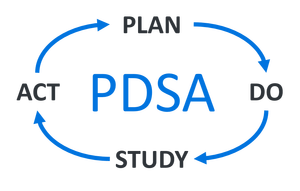
PDSA, or Plan-Do-Study-Act, is an iterative, four-stage problem-solving model used for improving a process or carrying out change.

When using the PDSA cycle, it's important to include internal and external customers; they can provide feedback about what works and what doesn't. The customer defines quality, so it would make sense to also involve them in the process when appropriate or feasible, to increase acceptance of the end result. (If you're unsure about, who your customers are, you may want to create a customer chain to assist in identification.)
In applying PDSA, ask yourself three questions:
Assemble a team that has knowledge of the problem or opportunity for improvement. Consider the strengths each team member brings—look for engaged, forward-thinking staff.
After recruiting team members, identify roles and responsibilities, set timelines, and establish a meeting schedule.
Describe what you want to accomplish in an aim statement. Try to answer those three fundamental questions:
Examine your current process. Start by asking the team these basic questions:
You might have already answered the last two questions if you have performed a SWOT analysis.
You may find it helpful to construct a swim lane map to visually describe your process.
Creating a process flow or at least depicting the current process can be very useful. If your team runs into road blocks, you might have found where the problem is occurring—or maybe the right person for identifying a missing step is not at the table.
Once the general structure is completed, these can be some more helpful questions to ask:
Using the aim statement created in Step B, state your desired accomplishments, and use data and information to measure how your organization meets/does not meet those accomplishments.
For example: If your objective is to maximize your staff's quality of work life, you might find evidence by surveying employees on workplace stressors.
Write a problem statement to clearly summarize your team's consensus on the problem. You may find it helpful to prioritize problems, if your team has identified more than one, and/or include a justification of why you chose your problem(s).
For the problem in your problem statement, work to identify causes of the problem using tools such as control charts, fishbones, and work flow process maps (e.g., flowcharts, swim lane maps). The end of the cause analysis should summarize the cause analysis by describing and justifying the root causes.
Examine your process, and ask:
Try to mitigate your root causes by completing the statement,
"If we do __________, then __________ will happen."
Choose an alternative (or a few alternatives) that you believe will best help you reach your objective and maximize your resources.
Develop an action plan, including necessary staff/resources and a timeline. Try to account for risks you might face as you implement your action plan.
Start to implement your action plan. Be sure to collect data as you go, to help you evaluate your plan in Stage 3: Study. Your team might find it helpful to use a check sheet, flowchart, swim lane map, or run chart to capture data/occurrences as they happen or over time.
Your team should also document problems, unexpected effects, and general observations.
Using the aim statement drafted in Stage 1: Plan, and data gathered during Stage 2: Do, determine:
You can use a number of different tools to visually review and evaluate an improvement, like a Pareto chart, control chart, or run chart.
The PDSA cycle is ongoing, and organizations become more efficient as they intuitively adopt PDSA into their planning.
Embracing Quality in Local Public Health (PDF)
Michigan Local Public Health Accreditation Program
Baldrige Performance Excellence Program
National Institute of Standards and Technology, US Dept. of Commerce
PDSA [Note: Video will autoplay]
Institute for Healthcare Improvement
Whiteboard: The PDSA Cycle (Part 1) [Note: Video will autoplay]
Whiteboard: The PDSA Cycle (Part 2) [Note: Video will autoplay]
Institute for Healthcare Improvement